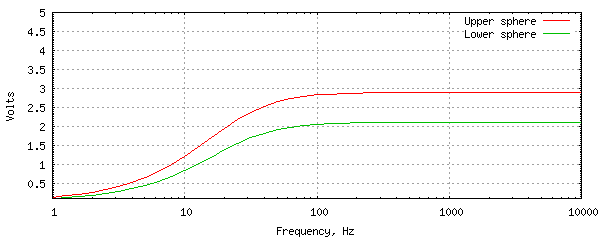An E-field dipole probe consisting of two 10cm diameter spheres positioned vertically with centers 1 metre apart. The dipole center is 2.5 metres off the ground.
The input file dipole.in contains
height = 2.5 ; Height of the dipole center
sphere_diam = 0.1 ; 10cm diameter spheres
spacing = 1.0 ; Sphere centers one metre apart
preamp_diam = 0.05 ; Space for preamp at center of dipole
electrode {
name upper_sphere
sphere {
center 0, 0, height + spacing/2
radius sphere_diam/2
}
wire {
end1 0, 0, height + spacing/2 - sphere_diam/2
end2 0, 0, height + preamp_diam/2
wirad 24 awg
}
}
electrode {
name lower_sphere
sphere {
center 0, 0, height - spacing/2
radius sphere_diam/2
}
wire {
end1 0, 0, height - spacing/2 + sphere_diam/2
end2 0, 0, height - preamp_diam/2
wirad 24 awg
}
}
ground {
center 0, 0, 0
axis 0, 0
}
field {
electric 0, 0 ; Vertical E-field
}
Generate a spice circuit with the command
lcng -o spice dipole
Create a test circuit with a resistor to ground from each sphere, representing the bias resistors of a differential front-end amplifier. The 5th pin of the sub-circuit is an input which sets the field strength. This is connected to a 1V AC source to represent a 1 V/m field in the model.
The file dipole-test.spice contains
Dipole .OPTIONS NOMOD NOPAGE .AC DEC 10 1 10K .PRINT AC V(2) V(1) .INCLUDE dipole.spice * 1 volt AC applied to pin 3 Vin 3 0 DC 0 AC 1.0 180 X1 0 1 2 3 dipole RB1 0 1 1G RB2 0 2 1G .ENDRun this with
ngspice -b dipole-test.spice > dipole-test.outPlotting the voltage on the two spheres gives
